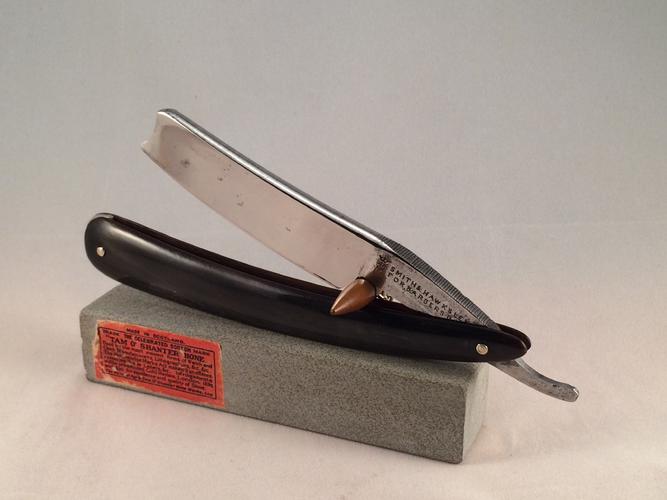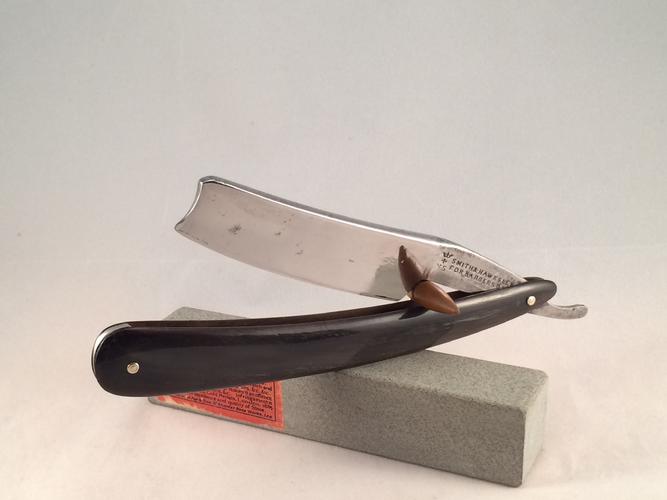Results 1 to 10 of 14
Thread: Tang tapering, wedges, etc.
-
03-23-2015, 10:43 PM #1Senior Member

- Join Date
- Feb 2015
- Location
- Florida
- Posts
- 507
Thanked: 49 Tang tapering, wedges, etc.
Tang tapering, wedges, etc.
In looking at pictures of razors, i have noticed that on some the tang is tapered from the plunge cut on back with chamfering on the bottom side of the tang where it meets up with the plunge, which means that the spacing at the pivot is narrower than the widest point of the blade. Obviously, wedges cause the gap between the scales to narrow even more at the butt end. Are these both done primarily in order to provide a "stop" so that that razor will only close so far? That seems to be the obvious purpose of using a wedge, but I am not sure about the tang and why it would be narrowed between the lunge and pivot than of that reason. I have also seem razors where there appear to be little taper to the tang in that regard and some that do not have a tapered wedge spacer. How do they work? Is that only done with really thin full hollow or frameback razors where the spine is the stop? I guess the underlying question is what are the construction techniques that have been developed over the years that that essentially allow the scales to perform the function of a stop pin for lack of a better way of putting it? I appreciate your comments.
Last edited by JDM61; 03-23-2015 at 10:46 PM.
-
03-23-2015, 11:28 PM #2

sure there is a reason for it
I also have an some like this especially an old SMITH & HAWKSLEY 13/16" tapered wedge that spine is thinner at the toe than the heal & then the tang is tapered to the tail with a slight vertical tapper also
I did read a post about it a year odd ago where the wedge needed to be tapered also to suit the tang as this makes the function of the swing fit right

 Saved,
Saved,
to shave another day.
-
03-24-2015, 12:38 AM #3At this point in time...




- Join Date
- Jun 2007
- Location
- North Idaho Redoubt
- Posts
- 26,961
- Blog Entries
- 1
Thanked: 13226
Watch the scales as you open and close the razor from the top down,,
You will see the flex, also note that the scales are in a slightly flexed position when the razor is closed, this actually strengthens them..
The entire design is to allow for a smooth action as the razor is opened closed and shaved with, it creates tension without the use of any springs..
As you look at the designs move through the centuries from the 1700 1800 and 1900's you can see the very slight changes that took place to the designs of the razors and therefore the designs of the scale..
Also to answer the unasked inevitable question
No the center pins that were added in the early to mid 1900's were not a stop, the tang does not actually touch them in properly functioning scales.. Many theories abound about why they are there never seen proof for any of them...
-
-
03-24-2015, 01:30 AM #4Senior Member

- Join Date
- Feb 2015
- Location
- Florida
- Posts
- 507
Thanked: 49
So Glen, is the objective even with single piece scales like the Hart Steel razors appear to have, for lack of a better way of putting it, have them bend in at the ends and bow in the middle so that the the thick part of the toe and the heel/tang junction are actually the "stops?"
-
03-24-2015, 12:44 PM #5

As a general rule, the wedge at its thickest end is designed to stop the blade at the desired height - i.e. both in terms of aesthetics and to ensure that the razor edge is fully covered by the scales. The shape of the wedge - degree of taper, should approximate the taper from spine to pivot. The scales should them bow sufficiently to allow the spine at its thickest part to sit within the scales without too much interference or bind.
My service is good, fast and cheap. Select any two and discount the third.
-
03-24-2015, 01:00 PM #6At this point in time...




- Join Date
- Jun 2007
- Location
- North Idaho Redoubt
- Posts
- 26,961
- Blog Entries
- 1
Thanked: 13226
I have no idea,,,
You shifted from Vintage style to a modern take on it, my experience with Hart scales has only been from the aspect of replacing them because of failures in the design or execution of the design...
ie: I don't think much of that particular system of scaling a razor...
Single piece scales should work exactly the same as a three piece system using a wedge.. So yes they should be adjusted to stop at a certain point on the sides of the blade at the toe... If you look at the Vintage versions on a one piece set or even the rare two piece, they all function exactly the same as the traditional three piece sets..
Also if you read what Rob wrote above you will note the part about the taper being correct so that there should be no binding at the tang area, that is the goal, so you end up with a smooth action..
This is an old thread about some of the issues with getting one piece scales to work correctly
http://straightrazorpalace.com/works...solutions.html
ps: I am not saying that this is the only way to do them, but I am saying that after 300 or so years of evolution of design they seem to work pretty well...Last edited by gssixgun; 03-24-2015 at 01:11 PM.
-
03-24-2015, 01:55 PM #7

I made a razor to fit Hart scales because of a request. It came out pretty good but the scales contact the blade at the middle close to the spine as well as at the toe. The middle contact point marks up the blade which has a pretty high polish. I don't think much of the one piece construction because of this. It would be the same with a non tapered spacer in place of the wedge.
-
03-24-2015, 04:14 PM #8

If you notice how Mastro Livi makes his one piece scales, he removes additional material from the insides round about where the tang/spine takeover occurs. It works, but I have to say it's not pleasing to the eye IMO.
My service is good, fast and cheap. Select any two and discount the third.
-
03-24-2015, 05:25 PM #9Senior Member

- Join Date
- Feb 2015
- Location
- Florida
- Posts
- 507
Thanked: 49
Interesting stuff, Thanks, guys.
-
03-24-2015, 05:29 PM #10Senior Member

- Join Date
- Feb 2015
- Location
- Florida
- Posts
- 507
Thanked: 49
Yes, 300 years would certainly result in multiple ways to skin a cat. As for the design of one piece scales, if properly shaped and "flexed" wouldn't the operation be the same even if it is a bit more difficult to pull off? The two piece design intrigues me. As for the proper taper in the tang area, does that require a bit of taper to the scales on the tip beyond the pivot or do you want a little bit of "bind" there when you open the razor?
Edit, By the way, Glen, that one piece rosewood handle is a very handsome piece. The administrators really need to add the "two thumbs up" smiley for things like that. Someone posted a rreamkrt about "top to bottom taper" Is that something you also do with scales?:
Someone posted a rreamkrt about "top to bottom taper" Is that something you also do with scales?:
Last edited by JDM61; 03-24-2015 at 05:37 PM.


 16Likes
16Likes LinkBack URL
LinkBack URL About LinkBacks
About LinkBacks






 Reply With Quote
Reply With Quote


